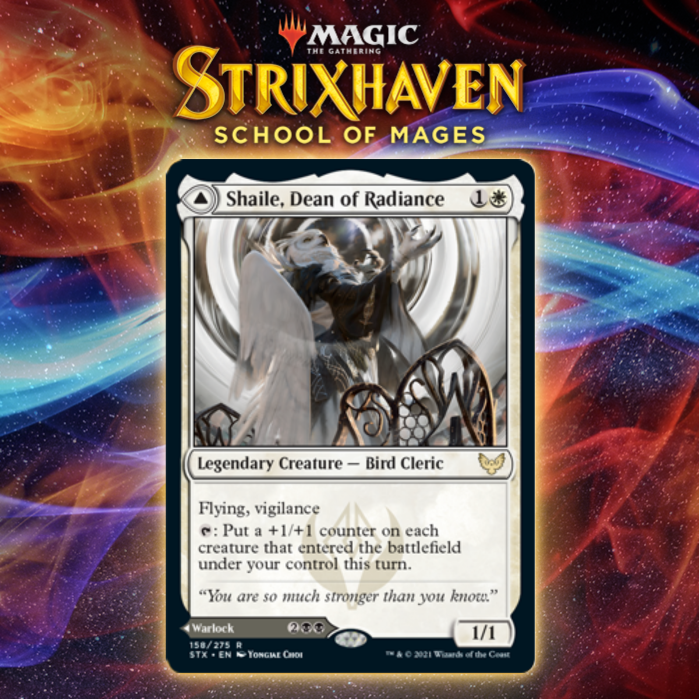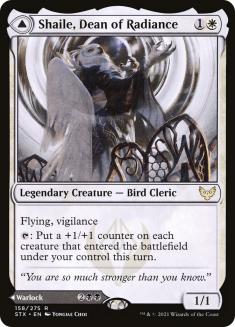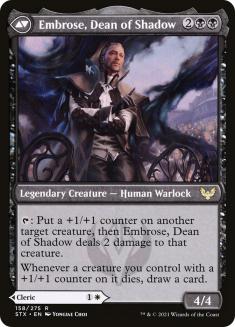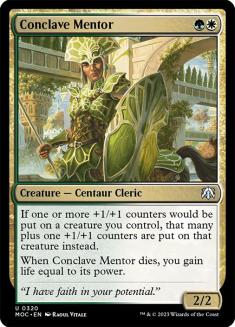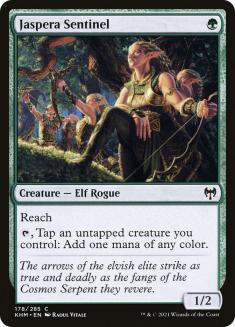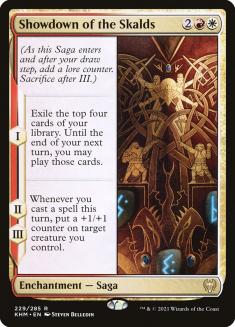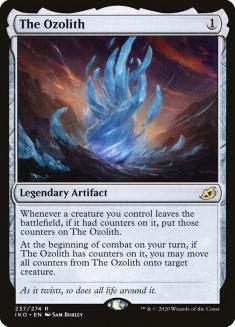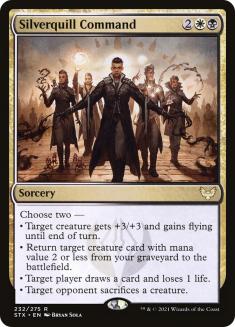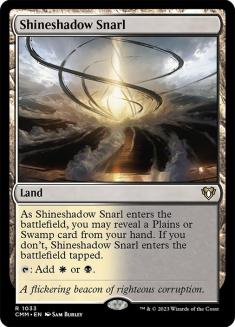Preview season for Strixhaven is underway, and the early previews are heavily centered around different cycles. That makes sense given that Wizards of the Coast (WotC) wants to introduce us to the different schools from the lore of Magic’s newest plane, but it’s also nice for us as players since we get to see how the different color combinations will play out.
One of the cycles that has caught my eye is the Deans, which Michael Majors featured in his article last week. You don’t often get a cycle of aggressively costed creatures, and the double-faced nature of these cards means there’s a lot of versatility packed into each one.
In particular, I have my eye on Shaile, Dean of Radiance. It’s a low-cost creature that threatens to dominate a game if left unchecked. The white decks in Standard have plenty of disruptive creatures, but are often left wanting when they try to rumble in the red zone against the likes of Lovestruck Beast and Bonecrusher Giant. Continuously pumping your later creatures either helps you trade effectively or makes racing in the air much easier.
And Shaile itselfcontributes to those races, since vigilance means it can both attack and use its ability. A point a turn may not seem like much, but it adds up. That vigilance also makes Shaile a great target for Maul of the Skyclaves and Luminarch Aspirant, since when large enough it can completely dominate combat. We’ve already passed the critical mass of quality white creatures necessary to make a mono-colored aggro deck viable in Standard, and Shaile only adds to that roster.
The one downside to Shaile is that it’s time-sensitive in that its effectiveness drops quickly if you don’t cast it early. But that’s another area where having flying and vigilance in a deck with plenty of ways to pump it is so important. Oftentimes any creature will do, so this downside is well-mitigated by the cards around it.
Of course, Shaile has a reverse side in Embrose, Dean of Shadow that incentivizes you to add black. This is the less attractive of the two halves, even if it reads rather nicely. To be honest, in 2021 a four-mana 4/4 is not a Constructed-quality rate on its own, especially in a Standard environment that’s largely defined by Lovestruck Beast. The activated ability has some applications, picking off Edgewall Innkeepers or pumping your other creatures, but without Shaile’s vigilance, you’re constantly torn between utilizing the body you paid for in combat and getting value from its ability. Frankly I don’t want to have to choose.
Embrose’s last ability is its best attribute, since Shaile and Luminarch Aspirant are great at spreading +1/+1 counters around, though even that is mitigated by the fact that the primary sweepers in Standard right now, Shadows’ Verdict and Extinction Event, are exile-based. Embrose would get much better if Doomskar finally lives up to its preview season hype, but for now it’s an afterthought.
That said, I’m still happy to have it there since Shaile is good enough by itself. That means Embrose is coming along for free, similar to how many decks play Jegantha, the Wellspring as a companion simply because they can. You won’t cast it that often, but when you do you’ll be glad it’s there. The important part is that you don’t pigeonhole yourself unnecessarily. Shaile isn’t an Orzhov card; it’s a white card that gets a bonus if you have black mana.
Moreover, Embrose comes along for free as a four-drop in aggro decks that want to have a low curve to take advantage of Shaile. Such decks often struggle if their draw stumbles at all, since their cards have a lower power level on an individual basis. Shoehorning a solid, if unexciting, four-mana creature into your deck gives you the opportunity to curve into more powerful threats when your early turns are weak or your opponent has plenty of cheap interaction. You can then build around Embrose by cutting your other four-drops for more cheap creatures, making your deck that much more consistent. So while Embrose may not be the most exciting card, it’s still quite valuable in the right shell.
The Obvious Home
Creatures (33)
- 4 Giant Killer
- 3 Alseid of Life's Bounty
- 4 Seasoned Hallowblade
- 4 Selfless Savior
- 4 Skyclave Apparition
- 4 Luminarch Aspirant
- 1 Usher of the Fallen
- 3 Reidane, God of the Worthy
- 3 Shaile, Dean of Radiance
- 3 Elite Spellbinder
Lands (24)
Spells (3)

Plenty of one-drops to flood the battlefield and enough disruption to stave off more powerful cards or answer a key blocker. The recipe here hasn’t changed, but Shaile and Elite Spellbinder are additional tools at your disposal. I’d like to see more copies of Usher of the Fallen to take advantage of Shaile, but space in this deck is very tight now, and the protection creatures are very important in keeping your Reidanes and Skyclave Apparitions around.
You could build a Mono-White Aggro list that’s more all-in around cheap creatures, Shaile, and other pump effects, but the disruptive creatures and good mana sinks are the most powerful elements of the deck. Shaile is powerful enough to earn a place, but I don’t think it’s good enough to make you want to rebuild the entire deck.
This means that while Mono-White Aggro is the obvious home, and a proven competitive one for Shaile, it’s not the home that’ll maximize everything the card brings.
Maximizing Shaile, Dean of Radiance
Creatures (31)
- 4 Stonecoil Serpent
- 4 Conclave Mentor
- 4 Swarm Shambler
- 4 Luminarch Aspirant
- 4 Clarion Spirit
- 4 Jaspera Sentinel
- 3 Shaile, Dean of Radiance
- 4 Star Pupil
Lands (16)
Spells (13)

When it comes to maximizing Shaile herself, the card we want is Clarion Spirit. Both cards want to be paired with plenty of other cheap creatures, and the tokens you generate with Clarion Spirit ensure that your first activation of Shaile is enough to put you far ahead on the battlefield.
Normally you’d think of Shaile as adding one counter each turn as you play out a natural curve. The next step is to try to double-spell on Turn 3 so you can create two counters with that activation. This deck does that well with a curve that’s entirely comprised of one- and two-mana creatures. Clarion Spirit takes it a step further, as casting it along with a one-drop on Turn 3 creates three creatures for Shaile to pump.
But we’re not stopping there. The final step comes from adding green for Conclave Mentor and Jaspera Sentinel. Conclave Mentor supercharges all this deck’s counter synergies, and the acceleration from Jaspera Sentinel makes it even easier to flood the battlefield with creatures. This leads to some incredible curves like the following:
- Turn 1: Jaspera Sentinel
- Turn 2: Shaile, Dean of Radiance
- Turn 3: Clarion Spirit, Conclave Mentor, activate Shaile
That curve leaves you with thirteen power spread across five bodies — impressive to say the least.
I also like Jaspera Sentinel for enabling a Clarion Spirit trigger on Turn 2 when you have a second one-drop, so you can guarantee your value without waiting until Turn 3. With the threat of Emergent Ultimatum, you have to put a ton of pressure on your opponents in Standard, and Jaspera Sentinel helps you do just that.
Showdown of the Skalds is my pick for the best top-end threat for this deck, over options such as Toski, Bearer of Secrets and Felidar Retreat. Pathways and Jaspera Sentinel make splashing red rather easy, and I think Showdown offers the best combination of card advantage to overcome disruption and additional pressure to close out games. Toski is best at drawing cards, but the 1/1 body isn’t ending games anytime soon. And while Felidar Retreat can theoretically create more threats and then pump your team, even with Fabled Passage you don’t have the land count to make it work consistently.
But Showdown continues the counter theme, so the synergy with Conclave Mentor is great, and pumping your flying Spirit tokens or Star Pupil is exactly what you need to break through stalled battlefields. The one piece of dis-synergy is with Stonecoil Serpent, which would love to take on extra counters but sadly can’t by virtue of its protection from multicolored ability.
“Shaile isn’t an Orzhov card; it’s a white card that gets a bonus if you have black mana.”
Because this list is building around the counter and Clarion Spirit synergies, there isn’t much room for disruption. Kabira Takedown is easy to incorporate into the mana base in small numbers, but the rest is in the sideboard. Skyclave Apparition and Bonecrusher Giant are the cream of the crop for answering creatures, and I love Gemrazer in this deck since you have so many good targets for Mutate. This suite of answers leaves you vulnerable to Goldspan Dragon, which is something to watch out for, but early on I’m looking to maximize my own deck, so having my removal stapled to creatures in my Shaile / Basri’s Solidarity deck is ideal.
The Ozolith is an attractive card for this deck, but one I’m often disappointed with. It’s only effective in matchups with plenty of removal, and even then you never want a second copy and the first isn’t essential. That makes it a perfect singleton in the sideboard to sit alongside Reidane as my anti-control package.
Using Every Part of the Card
Naya Counters is my favorite home for Shaile, but it’s still not taking advantage of Embrose, even if Jaspera Sentinel does offer some hope of casting it. So I’ll close with my first pass at an Orzhov shell:
Creatures (35)
- 1 Heliod, Sun-Crowned
- 2 Alseid of Life's Bounty
- 3 Vito, Thorn of the Dusk Rose
- 4 Speaker of the Heavens
- 4 Cleric of Life's Bond
- 4 Skyclave Apparition
- 1 Skyclave Cleric
- 4 Luminarch Aspirant
- 4 Righteous Valkyrie
- 4 Shaile, Dean of Radiance
- 4 Elite Spellbinder
Lands (14)
Spells (11)

I’ve tried to make Clerics work in Standard for a while now, and the tribe has consistently fallen short. There are some powerful synergies to build around with the lifegain cards, but so far I’ve found the curve to be too clunky to compete with the other aggressive decks in Standard. Embrose offering a free four-drop lets you play a lower curve than you otherwise would. Between Castles; Vito, Thorn of the Dusk Rose; and Heliod, Sun-Crowned, this deck has plenty of mana sinks, so you won’t often flood even with 24 lands and a low curve.
The major sacrifice you make in building the deck like this is Orah, Skyclave Hierophant, but if I’m being honest I’ve always come away unimpressed with the card. The ability is too restrictive to be effective, as there are plenty of exile effects in Standard, or your opponent can simply remove Orah before sweeping the other creatures. With the various +1/+1 counter effects in this deck, Embrose protects your battlefield from creatures just as well while having much more utility elsewhere.
The other major addition to this deck from Strixhaven is from another cycle in the set — Silverquill Command. It’s one of my favorites of the cycle because all of the modes are relevant. The pump mode can close the game, kill a planeswalker unexpectedly, or target a lifelinker to jump you to the magic life total of 27 for Righteous Valkyrie and Speaker of the Heavens. You have plenty of high-leverage two-drops to recur with the second mode, from Shaile to Luminarch Aspirant. And the final two modes offer solid value in a wide array of situations. In particular, the Edict effect can clear away pesky Elder Gargaroths without resorting to maindecking removal spells in your aggro deck.
Adding a new dual land in your colors may seem like a slam dunk, but given how poorly Shineshadow Snarl plays with Pathways and DFCs, I’m inclined to play Fabled Passage over it. Sometimes Snarl will represent an untapped land early that Fabled Passage doesn’t, but there are also times when you’ll need a fourth or fifth land and instead you draw an Orzhov Guildgate. The dual land would be more important if this deck had more stringent color requirements, but it’s mostly single-color costs so I’m not worried on that front.
Of course midrange and control decks get to play Triomes which can be revealed to Snarls, so once again they get to cast all their spells in as many colors as they want, while aggro decks struggle to play more than one. But I’m not mad at all. Not one bit.
But I suppose I can forgive some inequities in regards to manabase quality if WotC commits to printing interesting, powerful creatures at the low end of the mana curve. Shaile looks to be just the beginning when it comes to such cards in Strixhaven and I’m excited to see what else is coming along.

